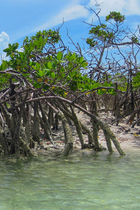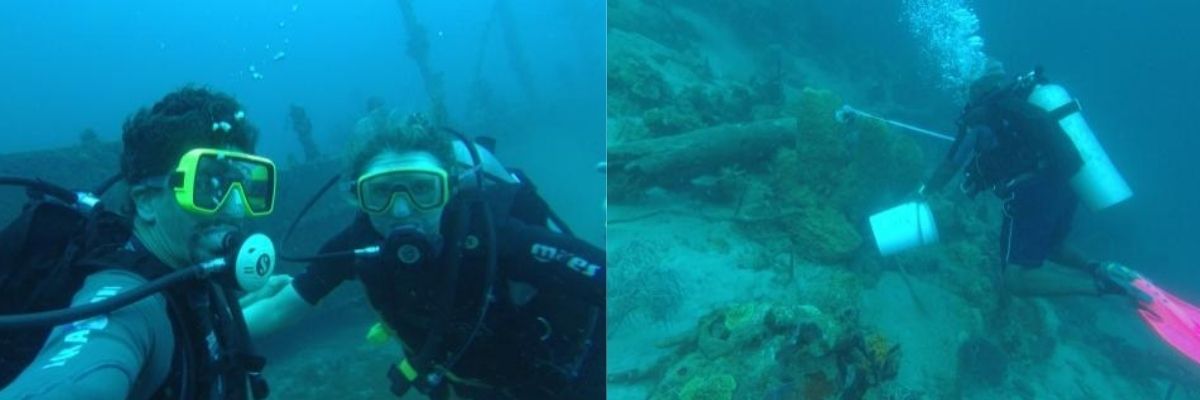Mission Ocean: What Nature Can Teach us About Hurricane Defence

It is undeniable. Hurricanes and natural disasters are getting more frequent - and more violent - with every season that passes. Loss of life and material damage are growing, with an estimated 1.35 million deaths related to hurricanes, floods, landslides and earthquakes worldwide between 1996 and 2015 (source: www.ramsar.org), and billions of dollars of property lost.
As I write this, I’m listening to the rain drum on SY Contigo’s roof. Outside, it’s around 32 degrees and from the cockpit window, I can see the green slopes of Le Marin, Martinique rolling up into the low cloud above Carenantilles shipyard. Today is the stormiest day we’ve had since we returned onboard ten days ago. The hurricane season is technically underway, and the first alert was sounded for Beryl a couple of weeks ago. And yet we are far from alone here in the yard, with upwards of 70 boats of all sizes – from tiny cruisers to big powerboats – and work going on late into the evenings.
What I can also see is the mangrove forest (salt tolerant trees and bushes that grow in saline water). Starting around 30m astern and 50m in front of us, the yard’s floating docks are surrounded by walls of these dense green bushes, and a section to protect and encourage their growth has even been fenced off and filled with soil.
Encouraging the mangrove to grow around the shipyard was a clever move. As well as providing a haven for birds, crabs, fish and other wildlife, mangroves offer excellent natural barriers against tidal surges, tsunamis and flooding linked to hurricanes and tropical storms. This is due to their huge root systems, which dissipate wave energy and slow tidal waters, retaining silt and sediment, thus also reducing the effects of tidal erosion.
Their aerial roots enable them to absorb gases and nutrients even at high tide, and also act as reserves, meaning that the mangrove plant has all it needs to thrive and grow even when its roots are submerged, and the “mangrove peat” created by decaying root and leaf matter contains a very high level of nutrients.
When Hurricane Sandy hit the USA in 2012, it is estimated that upwards of 625 million USD of flood damage to property was avoided due to the energy that was absorbed by the mangrove forests.The yard in Martinique, protected by thick mangrove forests. Photo credit: Carenantilles
Coral reefs have also been shown to have a similar effect on phenomena associated with hurricanes and tsunamis. In 2004, for example, the tsunami that hit Sri Lanka caused flooding up to 50m inland in Hikkaduwa, where the coastal reefs are protected by marine conservation projects. In neighbouring Peraliya, where the reefs had suffered significant damage from coral farming, the devastation stretched almost 1.5km inland.
Storm surges and large waves created by hurricanes cause damage to these natural barriers. We were able to witness some of this damage first-hand in Dominica, after Maria last year. We went diving with an instructor friend in the north of the island to check that a wreck had not shifted, or disappeared all together, and help to reduce the lionfish population that was thriving after the hurricanes (note that hunting lionfish with bottles is legal in Dominica).
We found tree trunks strewn across the reef, and evidence of broken, dead and dying coral in several locations. Back on the surface, our friend simply said that “Mother Nature will sort out the damage, it’s what she does best.”
And he was right. In the same way that forest fires have always existed and yet woodlands continue to thrive, nature has created a cycle balancing protection, destruction and regrowth of reefs in between storms. But today, climate change and human impact are being shown to disrupt this natural cycle, with rising sea temperatures and chemical products such as sun cream fragilizing coral, and the time for recovery between hurricanes growing shorter and shorter.
Deforestation is taking place in mangroves, and the land beneath the shallow waters is being reclaimed to build hotels and apartment complexes with sea views. As the frequency of hurricanes and tropical storms rises, it seems clear that we should be protecting and encouraging these natural barriers, and not destroying them, or eliminating them all together.

Diving in Dominica
So what can we do? The popularity of beach cleans has been growing over recent months, but have you thought about a mangrove clean up? If you are somewhere where mangrove trees grow, why not hop in a kayak or on a board and pick out some trash from those clever aerial roots, or donate a few dollars to a local group that organise clean ups? Boycott projects that are building into the mangroves, or write to your local government to express your concern. You can also participate in coral restoration projects, or donate to worthy causes online.
Or simply choose your products carefully: sunscreen products with a reduced impact on the oceans now exist, and some even participate in coral restoration and research into pollution. Our personal favourite is Aethic, who notably support coral conservation and sea grass plantations through their Going Blue Campaign and foundation.
Nature has done a pretty good job of keeping back the waves in the past, but our lifestyle choices and desire to build closer and closer to the oceans has meant that the natural barriers are breaking down and bringing that coveted sea view suddenly a lot closer to home.
Related articles:
Introducing Mission Ocean
Dominica After Hurricane Maria
Shelter from the Perfect Storm
Superyacht Aid Coalition: United Effort in the Caribbean


Post your comment
You cannot post comments until you have logged in.
Login to post a commentComments
No one has commented on this page yet.
RSS feed for comments on this page | RSS feed for all comments